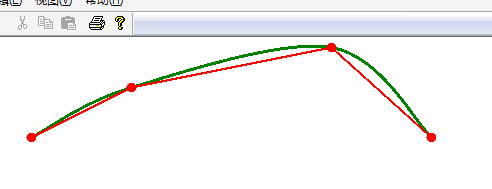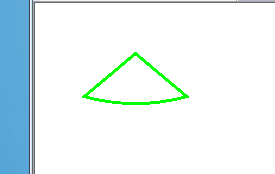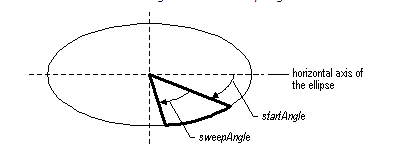《精通GDI编程》里的代码。在学习过程中对它加以总结,以防以后用到,全部代码都是在MFC 单文档中实现的,写在View::OnDraw(CDC */*pDC*/)中
画线/边框(Pen)
1、画单线-------DrawLine
- Pen pen(Color(255,0,0,0),3);
- PointF L_PTStart(0,0);
- PointF L_PTEnd(100,10);
- graphics.DrawLine(&pen,L_PTStart,L_PTEnd);
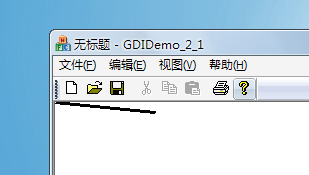
2、连接线--------DrawLines
- Pen blackPen(Color(255, 0, 0, 0), 3);
- PointF point1(10.0f, 10.0f);
- PointF point2(10.0f, 100.0f);
- PointF point3(200.0f, 50.0f);
- PointF point4(250.0f, 80.0f);
- PointF points[4] = {point1, point2, point3, point4};
- PointF* pPoints = points;
- graphics.DrawLines(&blackPen, pPoints, 4);
解说:points数组中的每一个点都是连接线上的转折点,DrawLines会把它们依照顺序一个个连接起来
3、画矩形-----DrawRectangle,仅仅画边框。不画背景色
- Pen blackPen(Color(255,255, 0, 0), 3);
- Rect rect(0, 0, 100, 100);
- graphics.DrawRectangle(&blackPen, rect);
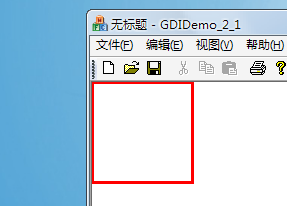
4、一次画多个矩形----DrawRectangles
- Pen blackPen(Color(255, 0, 255, 0), 3);
- // 定义三个矩形
- RectF rect1(0.0f, 0.0f, 50.0f, 60.0f);
- RectF rect2(60.0f, 70.0f, 70.0f, 100.0f);
- RectF rect3(100.0f, 0.0f, 50.0f, 50.0f);
- RectF rects[] = {rect1, rect2, rect3};
- //RectF是对Rect的封装
- graphics.DrawRectangles(&blackPen, rects, 3);
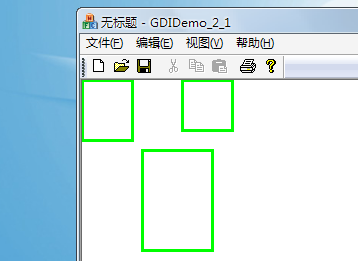
5、画曲线-----DrawCurve
- Pen greenPen(Color::Green, 3);
- PointF point1(100.0f, 100.0f);
- PointF point2(200.0f, 50.0f);
- PointF point3(400.0f, 10.0f);
- PointF point4(500.0f, 100.0f);
- PointF curvePoints[4] = {
- point1,
- point2,
- point3,
- point4};
- PointF* pcurvePoints = curvePoints;
- // 画曲线
- graphics.DrawCurve(&greenPen, curvePoints, 4);
- //画连接点和直线连接线
- SolidBrush redBrush(Color::Red);
- graphics.FillEllipse(&redBrush, Rect(95, 95, 10, 10));//画连接点
- graphics.FillEllipse(&redBrush, Rect(195, 45, 10, 10));
- graphics.FillEllipse(&redBrush, Rect(395, 5, 10, 10));
- graphics.FillEllipse(&redBrush, Rect(495, 95, 10, 10));
- Pen redPen(Color::Red, 2);
- graphics.DrawLines(&redPen,curvePoints,4);//画连接线
注意:这里为了比較画曲线与画直线连接线的差别。我用绿色画的曲线,用红色画的直线连接线。同一时候画出了连接点,大家能够比較一下。
6、画闭合曲线
- Pen greenPen(Color::Green, 3);
- PointF point1(100.0f, 100.0f);//開始点
- PointF point2(200.0f, 50.0f);
- PointF point3(400.0f, 10.0f);
- PointF point4(500.0f, 100.0f);
- PointF point5(600.0f, 200.0f);
- PointF point6(700.0f, 400.0f);
- PointF point7(500.0f, 500.0f);//结束点
- PointF curvePoints[7] = {
- point1,
- point2,
- point3,
- point4,
- point5,
- point6,
- point7};
- PointF* pcurvePoints = curvePoints;
- //画闭合曲线
- graphics.DrawClosedCurve(&greenPen, curvePoints, 7);
- //画连接点
- SolidBrush redBrush(Color::Red);
- SolidBrush startBrush(Color::Blue);
- SolidBrush endBrush(Color::Black);
- graphics.FillEllipse(&startBrush, Rect(95, 95, 10, 10));
- graphics.FillEllipse(&redBrush, Rect(495, 95, 10, 10));
- graphics.FillEllipse(&redBrush, Rect(195, 45, 10, 10));
- graphics.FillEllipse(&redBrush, Rect(395, 5, 10, 10));
- graphics.FillEllipse(&redBrush, Rect(595, 195, 10, 10));
- graphics.FillEllipse(&redBrush, Rect(695, 395, 10, 10));
- graphics.FillEllipse(&endBrush, Rect(495, 495, 10, 10));
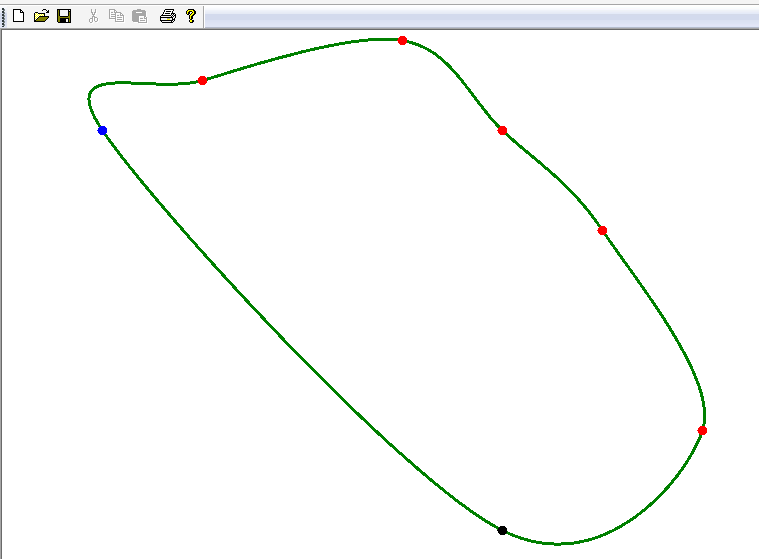
注意:蓝色点是開始点,黑色点是结束点
7、画多边形-----DrawPolygon,既然能画闭合的曲线。肯定也有闭合的直线。当然闭合的直线也就是所谓的多边形
- Pen blackPen(Color(255, 0, 0, 0), 3);
- //创建点数组,DrawPolygon会按这些点的顺序逐个连接起来
- PointF point1(100.0f, 100.0f);
- PointF point2(200.0f, 130.0f);
- PointF point3(150.0f, 200.0f);
- PointF point4(50.0f, 200.0f);
- PointF point5(0.0f, 130.0f);
- PointF points[5] = {point1, point2, point3, point4, point5};
- PointF* pPoints = points;
- // 画多边形,也就是闭合直线
- graphics.DrawPolygon(&blackPen, pPoints, 5);
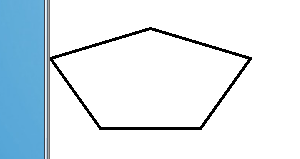
8、画弧线----DrawArc
- Pen redPen(Color::Red, 3);
- RectF ellipseRect(0, 0, 200, 100);
- REAL startAngle = 0.0f;//起始度数
- REAL sweepAngle = 90.0f;//结尾时的度数
- // 画弧线
- graphics.DrawArc(&redPen, ellipseRect, startAngle, sweepAngle);
- //画出边框,做为參考
- Pen greenPen(Color::Green, 1);
- graphics.DrawRectangle(&greenPen,ellipseRect);
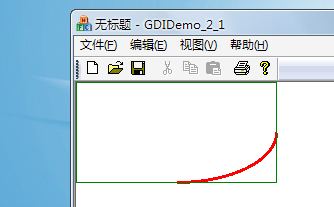
9、画扇形----DrawPie
- Pen blackPen(Color(255, 0, 255, 0), 3);
- // 定义椭圆。然后在里面截一部分作为终于的扇形
- RectF ellipseRect(0, 0, 200, 100);
- REAL startAngle = 40.0f;
- REAL sweepAngle = 100.0f;
- //画扇形
- graphics.DrawPie(&blackPen, ellipseRect, startAngle, sweepAngle);
这里要对它两上名词解说一下,什么叫startAngle(開始度数),什么叫sweepAngle(范围度数也能叫扫过度数,我译的。嘿嘿)
看下MSDN里对DrawPie函数的解说就会懂了,里面有这个图,给大家看一下
填充区域(SolidBrush)
1、填充闭合区域----FillClosedCurve,边框相应:DrawClosedCurve
- SolidBrush blackBrush(Color(255, 0, 0, 0));
- PointF point1(100.0f, 100.0f);
- PointF point2(200.0f, 50.0f);
- PointF point3(250.0f, 200.0f);
- PointF point4(50.0f, 150.0f);
- PointF points[4] = {point1, point2, point3, point4};
- //填充闭合区域
- graphics.FillClosedCurve(&blackBrush, points, 4);
- //为闭合区域画边框
- Pen curPen(Color::Green,3);
- graphics.DrawClosedCurve(&curPen,points,4);
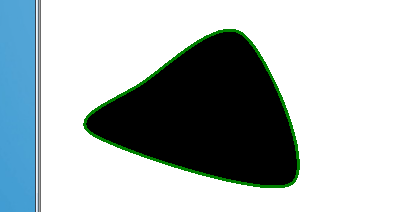
注意:从结果图中也能够看出填充区域(背景)和边框是分离的,用FillClosedCurve来填充背景色,用DrawClosedCurve来画边框
2、填充椭圆---FillEllipse。边框相应:DrawEllipse
- SolidBrush blackBrush(Color(255, 0, 0, 0));
- RectF ellipseRect(0.0f, 0.6f, 200.8f, 100.9f);
- //填充椭圆
- graphics.FillEllipse(&blackBrush, ellipseRect);
- //画边框,当然也能够不画
- Pen borderPen(Color::Green,3);
- graphics.DrawEllipse(&borderPen,ellipseRect);
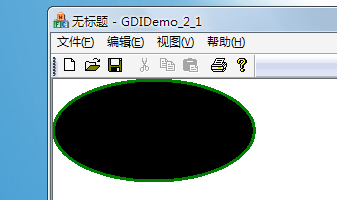
还有类似的几个函数。这里就不一 一解说了
它们是:
- FillPie(Brush* brush, RectF& rect, REAL startAngle, REAL sweepAngle) //填充扇形,相应DrawPie
- FillPolygon(Brush* brush, PointF* points, INT count) //填充多边形。相应DrawPolygon
- FillRectangle(Brush* brush, RectF& rect) //填充矩形,相应DrawRectangle
- FillRectangles(Brush* brush, RectF* rects, INT count) //同一时候填充多个矩形。相应DrawRectangles
还有是关于路径和区域的,先记下,后面再说
- Status FillPath( const Brush* brush, const GraphicsPath*path);
- Status FillRegion( const Brush* brush, const Region*region);
写字(SolidBrush)
形式一:Status DrawString( const WCHAR*string, INTlength, const Font* font, const PointF&origin, const Brush*brush);
- Graphics graphics(this->GetDC()->m_hDC);
- SolidBrush brush(Color(255,0,0,255));
- FontFamily fontfamily(L"宋体");
- Font font(&fontfamily,24,FontStyleRegular,UnitPixel);
- PointF pointf(0,0);//PointF类对点进行了封装。这里是指定写字的開始点
- graphics.DrawString(L"GDI写字",-1,&font,pointf,&brush);
- //DrawString还有另外两个重载形式,能实现更强大的功能
形式二:Status DrawString( const WCHAR*string, INT length, const Font*font, const RectF&layoutRect, const StringFormat*stringFormat, const Brush*brush);
- WCHAR string[256];
- wcscpy(string, L"Sample Text");
- // Initialize arguments.
- Font myFont(L"Arial", 16);//字体
- RectF layoutRect(0.0f, 0.0f, 200.0f, 50.0f);//矩形
- //设定字体格式
- StringFormat format;
- format.SetAlignment(StringAlignmentCenter); //水平方向的对齐方式,这里设置为水平居中
- format.SetLineAlignment(StringAlignmentFar);//垂直方向的对齐方式,这里设置为垂直居下
- SolidBrush blackBrush(Color(255, 0, 0, 0));
- //画矩形边框
- graphics.DrawRectangle(&Pen(Color::Green, 3), layoutRect);
- //填充矩形背景
- graphics.FillRectangle(&SolidBrush(Color(255,255,0,0)),layoutRect);
- //DrawString,一定要先画背景再写字,要不然,字会被背景覆盖
- graphics.DrawString(
- string,
- wcslen(string),
- &myFont,
- layoutRect,
- &format,
- &blackBrush);

形式三:Status DrawString( const WCHAR*string, INTlength, const Font* font, const PointF&origin, const StringFormat*stringFormat, const Brush* brush);
这样的形式是形式一与形式二的结合,指定写字開始点和字体格式,这里就不举例了。


